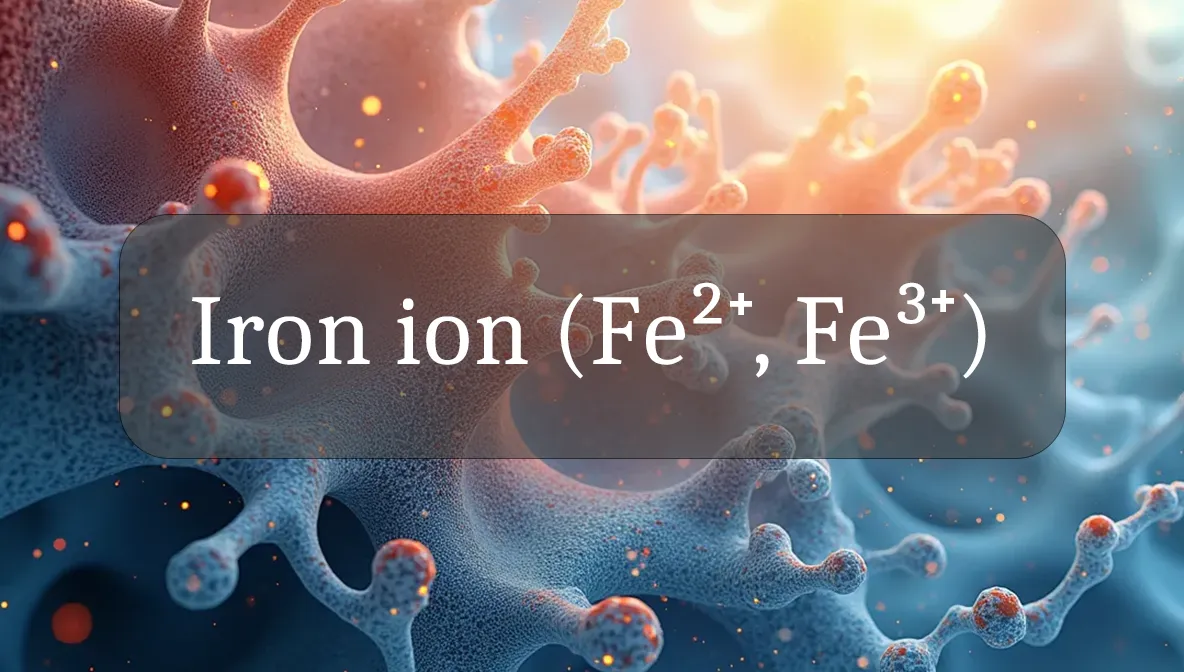Body’s Oxygen and Energy Carriers
Iron ions, specifically ferrous (Fe²⁺) and ferric (Fe³⁺), are essential trace elements that play critical roles in oxygen transport, energy production, and cellular processes. Found in foods, supplements, and the body, iron is vital for health but requires careful balance to avoid deficiency or toxicity. Let’s explore what iron ions are, their role in your wellness, and how to manage them for daily vitality.
Identity and Function
Iron ions are the charged forms of iron, a transition metal (~56 Da). Fe²⁺ (ferrous) is more bioavailable and reactive, while Fe³⁺ (ferric) is less soluble and often stored or transported. In the body, iron is primarily bound to proteins like hemoglobin (in red blood cells), myoglobin (in muscles), and ferritin (for storage). Iron ions cycle between Fe²⁺ and Fe³⁺ in processes like oxygen binding or electron transfer. Absorbed in the gut, iron is regulated by hepcidin and excreted minimally, mainly through skin or blood loss.
Biological Role and Health Impact
Iron ions are crucial for maintaining energy and overall health:
- Oxygen Transport: Fe²⁺ in hemoglobin binds oxygen in the lungs and delivers it to tissues, supporting stamina and organ function. Myoglobin stores oxygen in muscles for exercise.
- Energy Production: Iron ions in cytochromes and iron-sulfur proteins facilitate electron transfer in the mitochondrial respiratory chain, producing ATP via oxidative phosphorylation.
- Enzyme Function: Iron is a cofactor in enzymes like catalase (antioxidant defense) and ribonucleotide reductase (DNA synthesis), aiding cell repair and immunity.
- Immune Support: Iron supports immune cell proliferation and pathogen-killing by neutrophils, enhancing infection resistance.
- Brain Health: Iron aids neurotransmitter synthesis (e.g., dopamine), supporting cognition, mood, and motor function.
By enabling oxygen delivery and energy metabolism, iron ions keep you energized, mentally sharp, and resilient.
Production and Sources
Iron is not produced by the body but obtained externally:
- Natural Sources: Found in heme iron (meat, liver, 2–3 mg/100g; 15–35% absorption) and non-heme iron (spinach, lentils, 0.5–2 mg/100g; 2–20% absorption). Soil and water contribute trace amounts.
- Dietary Sources: Red meat (beef, 2.7 mg/100g), poultry, fish (tuna, 1 mg/100g), legumes (beans, 2 mg/100g), fortified cereals (up to 18 mg/serving), and supplements (e.g., ferrous sulfate, 65 mg elemental iron).
- Key Nutrients: Vitamin C (citrus, peppers) enhances non-heme iron absorption. Calcium (milk) and phytates (grains) inhibit it. Vitamin A (carrots) and zinc (nuts) support iron utilization.
- Environmental Exposure: Iron in well water or cookware (cast-iron pans) may contribute small amounts but is less significant.
A balanced diet with heme and non-heme sources ensures adequate iron intake.
Signs of Imbalance
Iron imbalances, from deficiency or overload, can disrupt health:
- Iron Deficiency:
- Symptoms: Fatigue, pale skin, shortness of breath, brittle nails, or hair loss from anemia (low hemoglobin). Cognitive issues or restless legs in severe cases.
- Affects ~1.2 billion people, especially women, children, and vegetarians. Serum ferritin <30 µg/L or hemoglobin <12 g/dL (women) indicates deficiency.
- Iron Overload (Hemochromatosis):
- Symptoms: Joint pain, fatigue, abdominal pain, bronze skin, or liver damage from excess iron storage. Can lead to diabetes, heart disease, or cirrhosis.
- Caused by genetic mutations (e.g., HFE gene) or frequent transfusions. Serum ferritin >300 µg/L (men) or transferrin saturation >45% suggests overload.
- Toxicity (Acute, Rare):
- Nausea, vomiting, or organ failure from ingesting high doses (e.g., >20 mg/kg supplements). Blood iron >500 µg/dL is life-threatening.
If you notice fatigue, skin changes, or joint pain, see a doctor for tests like complete blood count, serum ferritin, or transferrin saturation.
Supporting Healthy Function
To optimize iron levels and maintain health:
- Eat Iron-Rich Foods: Include heme sources (lean beef, chicken liver) 2–3 times weekly and non-heme sources (spinach, tofu) daily. Pair with vitamin C-rich foods (oranges, tomatoes) to boost absorption.
- Use Supplements Wisely: Take iron supplements (18–65 mg elemental iron/day) only if prescribed for deficiency, as excess can cause toxicity. Take on an empty stomach if tolerated.
- Balance Inhibitors: Limit tea, coffee, or calcium-rich foods during iron-rich meals to maximize absorption. Space supplements from antacids or dairy by 2 hours.
- Monitor Blood Loss: Women with heavy periods or individuals with GI bleeding (e.g., ulcers) need regular iron checks. Address underlying causes with medical care.
- Regular Checkups: Test iron status every 1–2 years, especially if pregnant, vegan, or with family history of hemochromatosis. Aim for ferritin 30–100 µg/L and hemoglobin 12–15 g/dL (women).
Safety and Precautions
Iron is safe in recommended doses but requires care:
- Medical Conditions: Anemia, hemochromatosis, or chronic diseases (e.g., kidney failure, cancer) affect iron metabolism, needing tailored management. Thalassemia or sickle cell disease increases overload risk.
- Medications: Iron supplements may interact with antibiotics (e.g., tetracycline) or proton pump inhibitors, reducing absorption. Discuss with your doctor.
- Excess Risk: Avoid high doses (>45 mg/day elemental iron) unless prescribed, as they can cause nausea, constipation, or organ damage. Keep supplements out of children’s reach.
- Deficiency Risk: Pregnant women (need 27 mg/day), infants, or vegetarians are prone to deficiency. Ensure fortified foods or supplements if needed.
- Toxicity Response: Seek immediate care for suspected overdose (e.g., vomiting, lethargy); call poison control and consider chelation therapy (e.g., deferoxamine).
If you have anemia symptoms, joint pain, or supplement concerns, consult a healthcare provider for tests like ferritin, iron studies, or genetic screening.
Fun Fact
Did you know your body recycles iron like a champ? Every day, it reuses ~25 mg of iron from old red blood cells to make new ones, making you a walking iron-recycling plant!
Citations
- National Institutes of Health (NIH): Iron Fact Sheet for Health Professionals.
- Centers for Disease Control and Prevention (CDC): Iron Deficiency Anemia.
- American Society of Hematology: Iron Metabolism and Health.
- Journal of Nutrition: Iron Bioavailability and Absorption (2020).
- Hepatology: Hemochromatosis and Iron Overload (2021).

